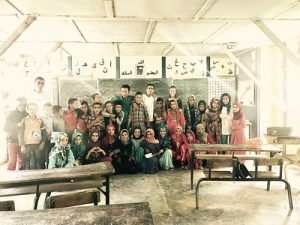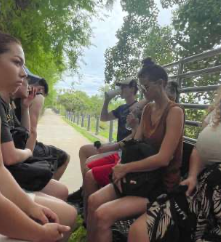How to Carry Out a Humanitarian Mission: A Comprehensive Guide to Successfully Engaging

Getting involved in a humanitarian mission is a rewarding experience that allows you to have a positive impact on communities in need while developing personal and professional skills. Whether you are a nursing student, a healthcare professional, or simply motivated by altruism, this guide will provide you with all the necessary steps to successfully undertake a humanitarian mission.
Globalong is committed to supporting its members throughout this humanitarian adventure by offering resources, training, and a support network to ensure a meaningful and secure experience.
1. Identify Your Motivations and Goals
Before embarking on a humanitarian mission, it is essential to clarify your motivations and objectives. Ask yourself the following questions:
- Why do you want to engage in a humanitarian mission?
- Which skills do you want to develop?
- What type of contribution do you wish to make?
Understanding your motivations will help you choose the mission best suited to your aspirations and ensure a sustainable and fulfilling commitment.
2. Choosing the Right Humanitarian Mission
There are a multitude of humanitarian missions in various fields such as health, education, construction, agriculture, and more. Here are some steps to select the mission that fits you best:
2.1 Identify Your Skills and Interests
Assess your professional and personal skills. For example, if you are a nurse, a health-related mission might be ideal. If you have educational expertise, a teaching mission could be more appropriate.
2.2 Research Humanitarian Organizations
Look for reputable organizations offering humanitarian missions. Ensure their credibility and transparency. Associations like Globalong are reliable examples.
2.3 Determine Location and Duration
Choose a country that interests you and where your skills will be helpful. Mission durations can range from a few weeks to several months. Think about how much time you can commit.
2.4 Evaluate Impact and Beneficiaries
Analyze the potential impact of your mission on the local community. Make sure the help you provide is sustainable and respects the real needs of beneficiaries.
3. Preparation Before Departure
Thorough preparation is crucial for the success of your humanitarian mission. Below are the main steps to follow:
3.1 Training and Skills
Pursue specific training if possible, depending on your chosen mission. For instance, first aid training, intercultural communication, or project management might be extremely helpful.
3.2 Health and Safety
Consult a doctor for necessary vaccinations and health advice. Obtain health insurance covering humanitarian missions, including repatriation in case of emergency.
3.3 Administrative Documents
Gather all required documents such as passports, visas, and any specific authorizations needed by the host country. Ensure your passport is valid for the entire duration of the mission plus at least six months afterward.
3.4 Logistical Planning
Organize your transport, accommodation, and local travel. Get information on living conditions and available infrastructure in the region.
3.5 Funding the Mission
Prepare a detailed budget covering all aspects of your mission, including travel, accommodation, food, and personal expenses. Explore various funding options such as fundraising.
4. Financing Your Humanitarian Mission
Funding is often one of the biggest challenges when undertaking a humanitarian mission. Here are some strategies to cover expenses:
4.1 Self-Funding
Use personal savings or set up a specific savings plan to finance your mission. This approach gives you total independence but requires careful financial planning.
4.2 Fundraising Events
Organize events such as charity dinners or fundraising evenings. Also use crowdfunding platforms to solicit online donations.
4.3 Scholarships and Grants
Look for scholarships and grants offered by organizations, foundations, or educational institutions. Some universities offer specific financial aid for humanitarian missions.
4.4 Sponsorship
Approach local businesses or individuals who might sponsor your mission in exchange for visibility or acknowledgment. Prepare a sponsorship dossier detailing your project and its impact.
4.5 Partnerships with Associations
Collaborate with associations like Globalong that can provide logistical support for your humanitarian missions. These partnerships can also connect you with a network of volunteers and resources.

5. Logistic Planning for Your Mission
Effective logistical organization is vital for a smoothly run humanitarian mission. Here are the main aspects to consider:
5.1 Transport and Accommodation
Book your plane tickets or other transport in advance to get better deals. Choose accommodation that suits your needs and budget, whether hostel stays, homestays, or dorms provided by the organization.
5.2 Equipment and Supplies
Prepare a list of the equipment and supplies required for your mission, depending on its focus: medical supplies, construction tools, educational materials, or communication devices.
5.3 Communication Plan
Establish a communication plan to stay in touch with your loved ones and your mission organization. This may involve purchasing a local SIM card, using secure messaging apps, or setting up a schedule of regular updates.
5.4 Safety and Risk Management
Identify potential risks related to your mission and implement proper safety measures. This could include first aid training, knowledge of local emergency procedures, and establishing emergency contacts.
6. On-Site Integration
Once there, harmonious integration within the local community is essential for the success of your humanitarian mission. Here are some tips to ease that process:
6.1 Respect for Local Cultures
Adapt to local customs, traditions, and social norms. Show respect for residents and their lifestyles to build trust and cooperation.
6.2 Teamwork and Collaboration
Work closely with other team members and local community members. Clear communication and effective collaboration are crucial to achieve shared goals.
6.3 Managing Challenges and Flexibility
Be prepared to face unforeseen challenges and adapt to changing circumstances. A positive and flexible attitude will help you overcome obstacles and remain motivated.
6.4 Continuous Training
Continue developing your skills throughout your mission. Attend trainings offered by your organization and look for learning opportunities on the ground.
7. Measuring the Impact of Your Mission
Measuring the impact of your humanitarian mission is essential to assess its effectiveness and value. Here’s how:
7.1 Define Success Indicators
Identify clear indicators to measure your mission’s success. This may include the number of beneficiaries helped, improvements in living conditions, or increased local skill sets.
7.2 Data Collection
Gather data before, during, and after your mission to assess changes and progress. Use tools like surveys, interviews, or direct observation.
7.3 Analysis and Reporting
Analyze the collected data to identify strengths and areas needing improvement. Compile a detailed report that can be shared with your organization and stakeholders.
7.4 Feedback
Share your feedback with other volunteers and with the Globalong community. This helps improve future missions and strengthens the support network.
8. Testimonials and Examples of Successful Humanitarian Missions
Testimonials from those who have already undertaken humanitarian missions are a source of inspiration and learning. Below are a few examples of successful missions carried out by members of Globalong:
8.1 Marie, Nurse
« Participating in a humanitarian mission was an incredible experience. I helped set up mobile clinics that improved healthcare access for isolated communities. This mission also allowed me to develop my skills in management and communication. »
Marie emphasizes the importance of adaptation and collaboration with local communities to ensure long-term project sustainability.
8.2 David, Nursing Student
« My mission gave me a unique perspective on public health challenges in difficult contexts. Working with residents gave me a deep sense of the impact we can have as health professionals. »
David highlights the importance of resilience and innovation in challenging environments.
8.3 Alice, Nursing Student on a Mission in India
« In India, I was able to take part in vaccination campaigns and health education programs. This experience taught me how to effectively work in multicultural teams and understand the specific needs of local populations. »
Alice underscores the importance of education and prevention in the field of public health.
9. Resources and Useful Tools for Your Humanitarian Mission
To help you undertake a humanitarian mission, here are some essential resources and tools:
- Humanitarian Organizations: Globalong
- Crowdfunding Platforms: Papayoux
- Language Training: Globalong
- Humanitarian Mission Insurance: Humanitarian Insurance
10. Conclusion: Embark on a Humanitarian Mission with Confidence
Engaging in a humanitarian mission is a unique opportunity to make a difference while enhancing your personal and professional journey. With this guide, you are now equipped to carry out a successful and impactful humanitarian mission.
At Globalong, we are dedicated to supporting our members through every step of their humanitarian commitment. For more resources, training, and mission opportunities, visit our website and join our engaged community.
Remember that every gesture counts, and your involvement can transform lives and communities. Embark on this human adventure with determination and passion.
FAQ: Everything You Need to Know about How to Undertake a Humanitarian Mission
What are the membership requirements for a humanitarian mission with Globalong?
To join a humanitarian mission with Globalong, you must be a member of the association, have a serious commitment, and fulfill the specific criteria of the chosen mission, such as professional skills or availability.
Are humanitarian missions with Globalong free of charge?
Humanitarian missions are generally not free. Mission fees include coordination, accommodation, food, etc.
Does a humanitarian mission guarantee a lasting impact on local communities?
Although each humanitarian mission has its own challenges, well-planned missions carried out in collaboration with local communities can create a lasting impact by strengthening local capacities and supporting sustainable projects.
How to manage stress and emotional challenges during a humanitarian mission?
It is essential to be mentally and emotionally prepared. Globalong offers stress management training, online mentoring sessions, and support to help you cope with challenges encountered on the ground.
Can I combine a humanitarian mission with my studies or work?
It depends on the duration and requirements of the mission. Some missions can be adapted to take place during school breaks or alongside academic and professional commitments. Discuss your plans with Globalong to find the best solution.

